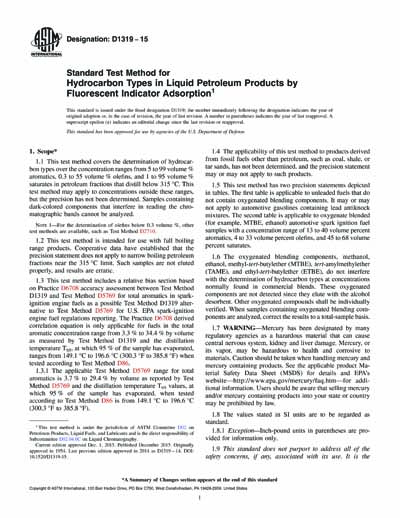Historical
ASTM D1319-15
Standard Test Method for Hydrocarbon Types in Liquid Petroleum Products by Fluorescent Indicator Adsorption
1.1 This test method covers the determination of hydrocarbon types over the concentration ranges from 5 to 99 volume % aromatics, 0.3 to 55 volume % olefins, and 1 to 95 volume % saturates in petroleum fractions that distill below 315 °C. This test method may apply to concentrations outside these ranges, but the precision has not been determined. Samples containing dark-colored components that interfere in reading the chromatographic bands cannot be analyzed.
1.2 This test method is intended for use with full boiling range products. Cooperative data have established that the precision statement does not apply to narrow boiling petroleum fractions near the 315 °C limit. Such samples are not eluted properly, and results are erratic.
1.3 This test method includes a relative bias section based on Practice D6708 accuracy assessment between Test Method D1319 and Test Method D5769 for total aromatics in spark-ignition engine fuels as a possible Test Method D1319 alternative to Test Method D5769 for U.S. EPA spark-ignition engine fuel regulations reporting. The Practice D6708 derived correlation equation is only applicable for fuels in the total aromatic concentration range from 3.3 % to 34.4 % by volume as measured by Test Method D1319 and the distillation temperature T95, at which 95 % of the sample has evaporated, ranges from 149.1 °C to 196.6 °C (300.3 °F to 385.8 °F) when tested according to Test Method D86.
1.4 The applicability of this test method to products derived from fossil fuels other than petroleum, such as coal, shale, or tar sands, has not been determined, and the precision statement may or may not apply to such products.
1.5 This test method has two precision statements depicted in tables. The first table is applicable to unleaded fuels that do not contain oxygenated blending components. It may or may not apply to automotive gasolines containing lead antiknock mixtures. The second table is applicable to oxygenate blended (for example, MTBE, ethanol) automotive spark ignition fuel samples with a concentration range of 13 to 40 volume percent aromatics, 4 to 33 volume percent olefins, and 45 to 68 volume percent saturates.
Content Provider
ASTM International [astm]






